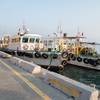GL Releases Guide for Ship Lay-Ups
Germanischer Lloyd (GL) has developed a guide outlining major methods and procedures involved in ship lay-ups. The guide gives technical assistance to shipowners focusing on the maintenance of class, ship's safety and operability.
Deactivating vessels in an effort to save costs requires planning and investment in the process. It is imperative that ships are laid up technically correctly to reactivate the ship successfully when the economic conditions are more favorable. "With our guide we offer technical consultancy support for the shipowners. On request, Germanischer Lloyd will also carry out surveys serving purposes such as consultation and cooperation in applying the necessary measures", explains Carsten Beese, Head of Competence Centre Fleet Service Management at Germanischer Lloyd. "
The most important question the owner has to clear is: How long will the vessel be laid up? Consequently, the owner has to take a decision on whether to opt for a hot or cold lay-up."
Shutting down a ship is a complex technical process. Additional to the technical challenges, the coordination with local and national authorities is important in the lay-up process. Lay-up conditions are determined by any local authority which has permitted vessels to be anchored off its coast. "The nature and extent of preservation required are governed by criteria such as duration of the lay-up time, place where the ship is laid up and corresponding climatic conditions, as well as general condition of the plant", Beese points out.
A hot lay-up is used to deactivate a vessel for a limited number of weeks. Reactivating a ship from a hot lay-up can be comparatively quick. The hot lay-up is achieved by having a small crew onboard the vessel in order to maintain full-time fire, leakage, moorings and security watch of the vessel with the minimum of machinery running. This ensures that the machinery, electrical and electronic systems are kept within tolerable temperature and humidity conditions by a crew that is familiar with the vessel. "Moisture is the main challenge with laying up a vessel with its complex software and circuitry", says Beese. "The guide recommends that air is kept de-humidified, as the consequences could be costly."
In addition, onboard inspections can be easily achieved as access is good, lighting is operational and it is relatively easy to find a berth for short term lay-up. There are scenarios for hot lay-up, where vessels are out of service for up to six months with reduced crewing levels but adhere to flag and class rules in order to be ready for quick reactivation.
For vessels that will be off the market for an extended period, the most likely scenario is a cold lay-up with a range of conditions placed on the vessel. "Effective reactivation from this type of deep lay-up can take anything from three weeks to three months, in the case of a five-year lay-up. Cold lay-ups can save more money but the vessel is out of service for at least a few months. Reactivation, in this case, could take weeks", explains Beese. "For that reason, many shipowners opt for a hot lay-up while they assess market conditions."
(www.gl-group.com)














